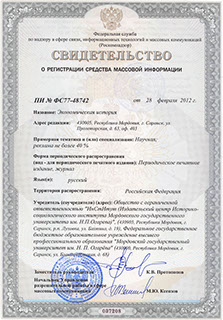Экономическая историЯ
Russian Journal of Economic History
ISSN 2409-630X (Print)
ISSN 2618-916X (Online)
Expert board:
- Scientific Council of RAS on economic history;
- Research and Educational Center «The economic history of Central Russia and the Middle Volga region» of Ogarev Mordovia State University;
- Center of Economic History of Lomonosov Moscow State University
Navigation
Certificate of registration

ISSN 2409-630X (Print), ISSN 2618-916X (Online)
DOI: 10.15507/2409-630X.058.018.202203.221-232
Mikhail I. Svyatkin
National Research Ogarev Mordovia State University (Saransk, Russia),
e-mail: mihail_svyatkin@mail.ru
Commercial Specialization of Mordva Settlements
Abstract
Introduction. The post-reform era was characterized by the rapid growth of handicrafts. This phenomenon was noted not only in the Russian, but also in the Mordva village. In some Mordva villages there was a concentration of a wide variety of types of handicrafts and they began to represent a kind of handicraft centers. The article pays attention to the study of the distribution of handicrafts among Mordva villages. On the basis of pre-revolutionary statistical documents, reports of provincial and county zemstvo committees, the level of development of fishing activity among the Mordva has been considered.
Materials and Methods. The research is based on the following methods: comparative-historical, historical-genetic, problem-chronological, structural-systemic. As the general scientific research methods, logical, descriptive-narrative, generalization, classification and systematization have been involved. To achieve the results of the study, archival sources, reports of county and provincial statistical committees, journals of meetings of county zemstvo assemblies have been used.
Results and Discussion. Mordva artisans lagged behind the Russians in terms of the rate of development of the handicraft industry. The same types of bushcraft were common among Mordva as among Russians. Handicraft production gradually expanded in the Mordva villages in the second half of the XIX – early XX century. Peasants begin to specialize in a certain kind of handicraft. Usually in the Mordva villages there were several handicrafts at once, but there were also those that specialized in one craft. In such settlements, as a rule, artisanal artels were created. So, in the Spassky district of the Tambov province, woodworking crafts dominated, in the Alatyr and Ardatov counties of the Simbirsk province – wool-cutting and felting, in the Saransk district of the Penza province, crew fishing was widespread. P. S. Pallas, I. I. Lepekhin, V. N. Kuklin, I. I. Firstov, A. S. Luzgin, N. F. Mokshin, G. A. Kornishina, E. N. Mokshina and others made a significant contribution to the study of traditional crafts and occupations of the Mordva.
Conclusion. Currently, certain types of craft activities are preserved in some Mordva villages. For example, felting is widespread in the villages of the Ardatovsky district of the Republic of Mordva – Urusovo, Zhabino, Old Ardatovo. In the village of Podlesnaya Tavla, Kochkurovsky district, Mordovian craftsmen are engaged in wood carving, making wooden toys. Crafts such as knitting, basket weaving, carpentry, birch bark weaving, cooperage are preserved.
Keywords: mordva, crafts, settlements, fishing specialization, economic activity.
For citation: Svyatkin M. I. Commercial specialization of Mordva settlements. Ekonomicheskaya istoriya = Russian Journal of Economic History. 2022; 18(3): 221–232. (In Russ.). DOI: 10.15507/2409-630X.058.018.202203.221-232.
© Ogarev Mordovia State University. History and Sociology Institute, 2017
68, Of. 411, Bolshevistskaya St., 430005, The editorial office of the scholarly journal «Russian Journal of Economic History»
Tel.: (8342) 24-25-90; 27-07-11, Fax: (8342) 24-25-90, E-mail: jurnal-econom-hist@isi.mrsu.ru
Designed by A. Napalkov, Email: napalkov@isi.mrsu.ru

